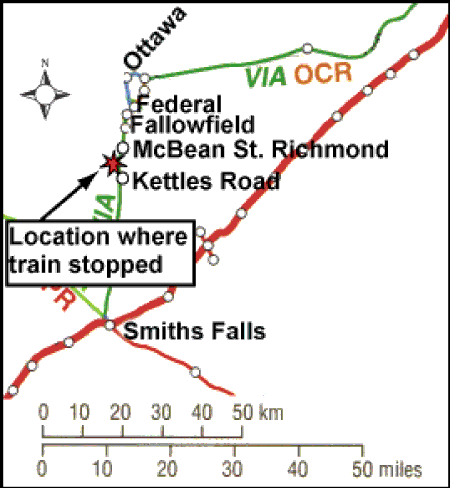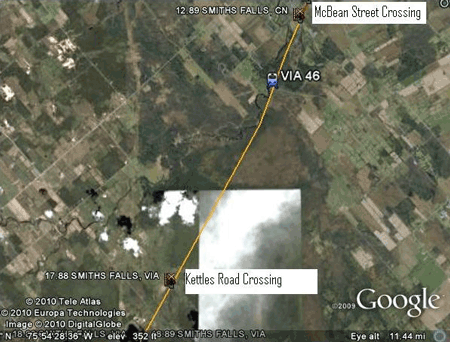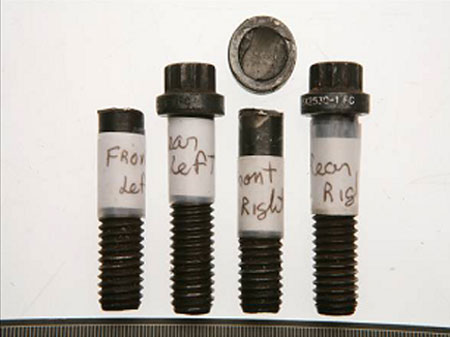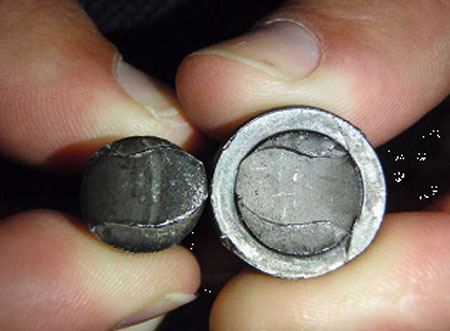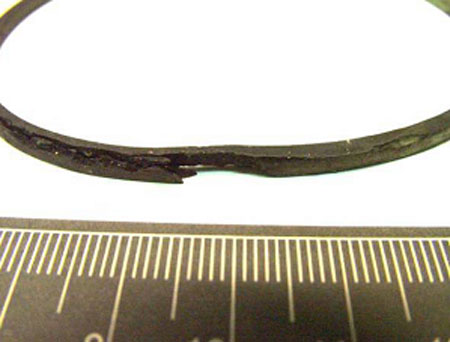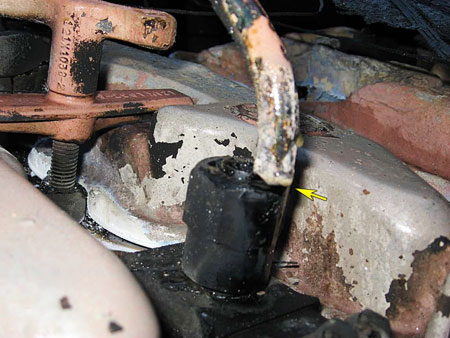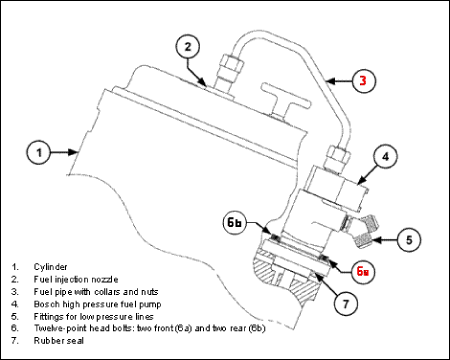Locomotive engine fire
VIA Rail Canada Inc.
Passenger Train 46
Mile 14.26, Smiths Falls Subdivision
Richmond, Ontario
The Transportation Safety Board of Canada (TSB) investigated this occurrence for the purpose of advancing transportation safety. It is not the function of the Board to assign fault or determine civil or criminal liability. This report is not created for use in the context of legal, disciplinary or other proceedings. See Ownership and use of content. Masculine pronouns and position titles may be used to signify all genders to comply with the Canadian Transportation Accident Investigation and Safety Board Act (S.C. 1989, c. 3).
Summary
On Sunday, 16 August 2009 at 2005 Eastern Daylight Time, the locomotive diesel engine of VIA Rail Canada Inc. passenger train 46 caught fire while the train was travelling eastward at about 95 mph. A loss of power caused the diesel engine to shut down and the brakes to apply. The train came to a stop at Mile 14.26 of the Smiths Falls Subdivision, near Richmond, Ontario. A total of 323 passengers were evacuated. There were no serious injuries to the passengers; however, one of the locomotive engineers required medical attention for exposure to smoke and fumes.
Ce rapport est également disponible en français.
Factual information
On 16 August 2009, VIA Rail Canada Inc. (VIA) passenger train 46 (the train), which operates daily eastwardFootnote 1 between Toronto, Ontario, and Ottawa, Ontario, was comprised of one locomotive (VIA 902) and five light, rapid, comfortable (LRC) passenger cars. The train weighed 373 tons and was 495 feet in length. The train crew consisted of two locomotive engineers and five on board services (OBS) personnel who were located throughout the train.
At 2005,Footnote 2 while travelling at 95 mph and approaching Richmond, Ontario, on VIA's Smiths Falls Subdivision (see Figure 1 and Figure 2), the train experienced a loss of power. An unsuccessful attempt was made to restore power. Shortly thereafter, smoke and flames came from the engine compartment on the locomotive. There was no fire detection system in the engine compartment of this locomotive. The emergency fuel cut-off switch was then activated by the crew.
When the locomotive shut down, the train brakes applied automatically. At 2008, with the train stopped at Mile 14.26, the rail traffic controller (RTC) was notified of the situation. Shortly thereafter, VIA Operations Control Centre (OCC) was also advised.
Smoke started to migrate to the passenger cars and the lights inside the cars flickered. An evacuation towards the rear of the train was initiated. As per standard operating procedures, the heating, ventilation and air conditioning (HVAC) system on all cars was shut down.
Both locomotive engineers detrained. With the use of a fire extinguisher, burning debris under the fuel tank and a small fire on the side of the locomotive were extinguished. However, due to the intensity of the fire inside the engine compartment of the locomotive, the crew was unable to extinguish this fire. The engine fire remained burning for at least 15 minutes and then went out on its own before firefighters arrived.
Smiths Falls Subdivision
The Smiths Falls Subdivision is owned by VIA. It is single main track between Mile 0.0 at Federal (Ottawa) and Mile 34.5 at Smith Falls East. Train movements in the vicinity of the occurrence are governed by the Occupancy Control System (OCS) method of train control, as authorized by the Canadian Rail Operating Rules (CROR) and supervised by a RailTerm RTC located in Dorval, Quebec. The authorized timetable speed in the vicinity of the occurrence was 95 mph for passenger trains. Approximately 8 to 10 passenger trains traverse the subdivision on a daily basis.
Crew information
The two locomotive engineers were qualified for their respective positions and met company and regulatory fitness and rest standards. One locomotive engineer was designated as the in-charge locomotive engineer (ICLE) and the second as locomotive engineer. The OBS personnel consisted of one service managerFootnote 3 and four senior service attendants who were all qualified for their respective positions and met company and regulatory standards.Footnote 4 All OBS crew members were able to speak both official languages.
Post-occurrence examination of VIA 902
VIA 902 was a Genesis P42 locomotive manufactured by General Electric (GE). It entered into service in 2001. Post-occurrence examination of the locomotive determined that the fire started at the top of the L2 power assembly of the V-16 diesel engine (see Figure 3).
A broken high-pressure fuel injection line that connected the fuel injection pump with the fuel injector was discovered. Two of the four fuel injection pump mounting bolts were broken and the O-ring gasket at the base of the fuel injector pump was damaged.
The broken high-pressure fuel injection line, the four mounting bolts, the fuel injector pump and the damaged O-ring gasket were sent to the TSB Laboratory for analysis (LP 121/2009).
Laboratory analysis of fuel injector pump
Laboratory analysis of the fuel injector pump and associated securement and connecting components determined the following:
Fuel Pump Mounting Bolts (see photos 1 and 2)
- The mounting bolts used to fasten the L2 fuel injector pump to the cylinder were the original bolts that had been installed during factory assembly.
- The fuel injector pump front mounting bolts (left and right) failed due to progressive (high-cycle fatigue) cracking.
- The fatigue cracks advanced in different intersecting directions, which was most obvious in the case of the front right mounting bolt (see Photo 2).
- No discrepancies were found when compared with the mounting bolt specifications (that is, dimensions and material).
O-Ring Gasket (see Photo 3)
- A portion of the rubber O-ring gasket had jammed between the pump base plate and the cylinder seat. There were scrapes and small cuts along half of the outside surface of the gasket, including a 15 mm longitudinal tear and a 10 mm missing portion.
High-Pressure Fuel Injection Line (see Photo 4)
- Subsequent to the bolt failure, the fuel pump-to-cylinder joint became loose, leading to the development of fatigue cracks in the high-pressure fuel injection pipe.
- The fuel injection line broke in overstress mode due to the reduction of its load-bearing cross-section.
Mechanical inspection of locomotives
On 17 April 2008, VIA 902 underwent an "H" maintenance inspection (that is, required every 547 days) as per VIA maintenance procedure P142/0129 at the Montréal Maintenance Centre (MMC). During this maintenance procedure, the O-ring gasket was replaced on all fuel injector pumps. To facilitate O-ring gasket replacement, pump installation procedures state (in part):
- Remove the mounting bolts at the base of the pump using the special wrenches. Lift the pump from the engine. Remove and discard the square cut O-ring from the groove in the jacket. Ensure groove is clean and free of all foreign matter.
- Inspect the removed O-ring for indication of installation error, (e.g., pinched between pump mounting base and cylinder jacket or double gaskets). If any error is apparent, discard the mounting bolts.
- AN IMPROPERLY SEATED O-RING MAY CAUSE FUEL-OIL LEAKAGE AND/OR MOUNTING BOLT FAILURE, RESULTING IN A FUEL-OIL INTEGRITY ISSUE.
- Apply a new sealing square cut O-ring to the pump mounting cavity groove and ensure it seats squarely and fully into the groove.
- Install the pump on the cylinder taking care not to displace the O-ring from the groove.
- Install the mounting bolts and torque to 114-126 NmFootnote 5 (83-93 ft-lbs) in a criss-cross pattern in 41 Nm (30 ft-lbs) increments. Use the special GE wrench 147X2460.
- Mark torqued bolts with a grease stick.
During this maintenance procedure, adjustment of the fuel injector pumps was also performed. The fuel injector pumps were removed, timing was checked, and the fuel injector pumps were reinstalled. This was the last mechanical maintenance procedure conducted on the fuel injector pumps before the occurrence.
On 13 August 2009, three days before the occurrence, VIA 902 underwent a "C" maintenance inspection (that is, required every seven days) at the VIA MMC. This maintenance procedure (P142/003) involved inspection of the fuel injector pump assembly (see Figure 4). During this activity, any identified leaks should be corrected by tightening the connections, renewing gaskets or seals and replacing defective components as required. During the August 13 "C" inspection, no anomalies related to the fuel injector pump assembly were noted.
On 30 September 2009, at the MMC, TSB investigators observed the installation of a new fuel injection pump on a VIA locomotive. During this installation, it was noted that, while the mounting bolts were torqued in a criss-cross pattern, the requirement to tighten the mounting bolts in 30 ft-lbs increments was not followed. Instead, 90 ft-lbs of torque was applied to each mounting bolt individually.
Passenger evacuation and emergency response
During the evacuation of the train, no announcements could be made over the public address (PA) system due to the loss of power within the train. OBS personnel in each car directed the passengers towards the rear of the train and instructed them to leave their luggage behind. Some instructions were given in English and some in both official languages. When answering questions from passengers, responses were provided in the language that the question was asked.
With no side doors on the car at the rear end of the train, some passengers detrained from the rear door where there were no steps. The distance to the ground was approximately 1 m. The first OBS employee to detrain injured his ankle, but was able to continue assisting passengers with the evacuation. All other OBS personnel remained in their respective car to coordinate the evacuation of passengers.
A passenger was also asked to assist with the evacuation. This person had received a pre-trip emergency briefing because he was an able-bodied passenger who had been sitting near the exit. The assisting passenger and the OBS employee positioned themselves at track level on each side of the rear door as the passengers detrained. Shortly afterwards, when congestion occurred at the rear door, OBS personnel gave instructions to the remaining passengers to exit from the side doors of each passenger car to accelerate the evacuation.
At approximately 2013 (that is, 5 minutes after the train stopped), OBS personnel confirmed that all 323 passengers had detrained. The passengers were then instructed to walk westward on the track to a safe location from the rear of train and to wait for further instructions.
During the evacuation, the trauma kitFootnote 6 from each passenger car was accessed and taken from the train. Four flashlights from each of the five trauma kits provided the OBS personnel and passengers with 20 flashlights. Reflectorized arm bands were available for each of the OBS personnel. The trauma kits did not contain insect repellant. A defibrillator and an oxygen canister were also carried separately from the train during the evacuation.
Shortly after the train stopped, the locomotive engineer started walking eastward towards the McBean Street crossing (a distance of 1.37 miles) to meet with the emergency responders and to help coordinate the emergency response. Approximately 20 minutes later, the locomotive engineer arrived at the crossing. The ICLE had stayed at the head end of the train to communicate with the service manager and the RTC. Before the locomotive engineer had departed, the train crew members had agreed to update each other at least every 10 minutes by portable radio. However, they lost contact after their first and only en route communication. To maintain communications during the evacuation and emergency response, the ICLE obtained the service manager's cellular telephone by walking past the locomotive engine fire and also re-entered the smoke-filled locomotive cab a number of times to use the (more powerful) cab radio.
The McBean Street crossing was established as the staging area. At 2025, a RailTerm maintenance foreman (foreman) arrived at the crossing by hi-rail vehicle. Other railway maintenance personnel in hi-rails arrived shortly after. Emergency first responders began to arrive at 2038. At 2041, the foreman requested a track occupancy permit (TOP) to occupy and use the main track, but was not given authorization until 2053. The RTC was unable to provide authorization until a General Bulletin Order was issued to permit the train crew to leave the train on the main track and the train's track authorization was cancelled.
Once authorized, the RailTerm personnel transported the emergency responders from the McBean Street crossing to the train. Shortly thereafter, evacuation of the passengers from the site commenced. Hi-rail vehicles were used to transport some passengers to the staging area at the McBean Street crossing, while other passengers walked. Special arrangements were made for some passengers (that is, unaccompanied children). In addition, some passengers with difficulty walking were transported by hi-rail westward to the Kettles Road crossing (approximately 3.5 miles) and then transported to the staging area by ambulance. By about 2330, all passengers and crew had been taken by bus from the McBean Street crossing staging area en route to the designated train stations (Fallowfield and Ottawa). Appendix A presents a detailed timeline for the passenger evacuation and emergency response.
VIA Rail Canada Inc. protocols for emergency situations involving passenger evacution
VIA emergency response procedures are defined in three manuals:
- Guide to On-Train Services (GOTS),
- Train Emergency Response Plan (TERP), and
- Emergency Measures Organization (EMO).
OBS personnel are required to have a copy of the GOTS accessible while on duty. This document is the main reference in case of an emergency. The TERP is a supplement to the GOTS. While on the train, OBS personnel have access to the GOTS, but they do not have access to the EMO, which provides additional detail for emergency procedures.
The GOTS has a dedicated section on emergency response procedures. That section indicates that:
- OBS personnel are to ensure that evacuation is carried out assertively and safely, and
- Calm informative announcements are made in both official languages on a timely basis.
The GOTS does not provide specific wording to be used for an emergency evacuation. The EMO indicates that, for an emergency evacuation, the following announcement should be made:
- LADIES AND GENTLEMEN, YOUR ATTENTION PLEASE. FOR YOUR OWN SAFETY, PLEASE LEAVE THIS CAR IN THIS DIRECTION (point the direction).
The GOTS indicates that the service manager can enlist assistance from off-duty employees or passengers if required. The GOTS also stipulates that the marshalling command post should be established at a minimum distance of 300 m from the train.
Pre-departure safety briefings
Before departing the Toronto Union Station, OBS personnel conducted a pre-departure safety briefing. Passengers in each car of the train were also provided a standard announcement on the PA system to inform and encourage them to read the safety pamphlet located in the seat back pocket in front of them. Additionally, for passengers seated next to emergency exits, instruction was provided on how to open the exits in the event of an evacuation.
Rail traffic controller activities
RailTerm has two RTCs on duty for each 12-hour shift during weekend days. There is no on-site supervisor on weekends. The day shift is from 0600 to 1800 and the night shift is from 1800 to 0600. When an emergency occurs, the on-duty RTC assigned to the territory will normally handle the additional workload generated by the emergency, as well as perform his or her regular duties. If required, the supervisor can be contacted and can assist from home because he or she has full information access. The supervisor can also choose to return to the office to assist. Common practice in larger rail traffic control centres is for the on-site supervisor to assist in times of heavy workload such as during emergencies.
During the 45-minute period after being notified of the occurrence, the RTC was occupied for about 40 minutes with tasks directly related to this occurrence and for about 2 minutes with other RTC tasks (see Appendix B). He handled a total of 27 individual telephone or radio conversations in this period. Just before the incident, the RTC was handling 6 train movements on all territories under his authority. The second RTC answered some of the phone calls, but would place the calls on hold until the occurrence RTC was available.
Emergency lighting in passenger cars
After auxiliary power from the locomotive shut down, emergency lighting in the passenger cars came on and lasted for about 30 minutes. The emergency lighting system was operational until after the passengers had been evacuated from the train.
In 2006, the power supplies for the emergency lighting systems on all VIA LRC2 and LRC3 cars (which included the cars on the train) were modified to nickel-cadmium (NiCd) batteries. According to specifications, these batteries were expected to provide 1.5 hours to 2 hours of power during emergency lighting conditions. Railway records indicate that the batteries were inspected and tested at the prescribed intervals (that is, in February 2009 and August 2009) with no discrepancies noted.
Analysis
The analysis will focus on the reasons for the failure of the high-pressure fuel injection line on locomotive VIA 902, coordination activities during passenger evacuation, and RTC activities during this emergency.
The accident
The accident occurred when the diesel engine on VIA 902 caught fire. A broken high-pressure fuel injection line led to the release of fuel. The fuel contacted the hot surface of the engine exhaust manifold and ignited.
Laboratory analysis determined that the O-ring gasket, which is intended to ensure proper fit of the fuel injector pump, had been pinched between the fuel injector pump base plate and its cylinder seat. During normal train operation, this misaligned fuel injector pump created excessive vibration of the pump, leading to progressive, high-cycle fatigue cracking and failure of two of the four mounting bolts that secure the pump to its seat. Once the fuel injector pump was loose, continued vibrations led to fatigue cracks and the eventual failure of the high-pressure fuel injection line.
The TSB observed a fuel injector pump change out after the accident and noted that the torquing of the mounting bolts was not conducted in increments of 30 ft-lbs as required by procedures. Instead, the installation was performed with each mounting bolt receiving the approximate 90 ft-lbs of torque individually. Improper torquing can lead to an improper seated O-ring gasket. As indicated in the fuel injector pump installation procedures, there is a correlation between an improperly seated O-ring gasket and the failure of the mounting bolts.
Although it is not known what torquing procedure was used when the fuel injector pump was installed on VIA 902 during its last "H" inspection, it is possible that a similar procedure (that is, 90 ft-lbs applied individually) had been used. Applying all of the required torque to the mounting bolts at once, rather than incrementally in a criss-cross pattern, may have caused the displacement of a portion of the rubber O-ring gasket.
Re-use of fuel injector pump mounting bolts
Examination of the bolts revealed that fatigue cracks had advanced in different intersecting directions. This suggests a change in the direction of the applied stresses. The most probable explanation for such a change is rotation of the bolts. The bolts could have turned on their own if they became loose during operation, or they could have been installed at a different turn position during removal and re-installation of the fuel injector pump. The re-use of fuel injector pump mounting bolts during scheduled maintenance increases the risk that bolts will fail in service due to undetected fatigue cracking, leading to locomotive engine fires.
Communicating evacuation instructions to passengers
Once advised of the decision to evacuate, OBS personnel gave directions to the passengers in each car. The exact words as prescribed in procedures were not used by OBS personnel when directing the evacuation. Not all OBS personnel gave instructions in both official languages. Evacuation of all 323 passengers was completed within five minutes. Safe and timely train evacuation was not impeded by the manner in which evacuation instructions were communicated to the passengers.
Maintaining communications between train crew members
Shortly after the train stopped, the locomotive engineer started walking eastward towards the McBean Street crossing to meet with the emergency responders and to help coordinate the emergency response. For maintaining communications during the emergency, the detrained locomotive engineers initially only had portable radios that were only effective for a short distance. As the locomotive engineer walked towards the McBean Street crossing, he lost contact after the first and only communication with the ICLE. In addition, the locomotive engineer, while en route to the McBean Street crossing, was not able to communicate with emergency responders, VIA, the RTC and OBS personnel to start organizing the emergency response.
To facilitate communications, the ICLE walked past the locomotive engine fire to obtain the service manager's cellular telephone. In addition, he re-entered the smoke-filled locomotive cab a number of times afterward to use the cab radio to maintain communications with the locomotive engineer and the emergency responders. While the emergency response was developing, periodic updates could not be immediately provided to the waiting passengers due to the communication difficulties experienced between train crew personnel and emergency responders positioned at the staging area.
Rail traffic control workload during emergency situations
The foreman was not given a TOP to reach the disabled train using a hi-rail vehicle until 45 minutes after the occurrence was reported to the RTC. He had arrived at the McBean Street crossing within 17 minutes and was able to assist immediately. In addition, fire department personnel arrived at the staging area within 30 minutes.
Some of the 45-minute delay was due to difficulties in establishing and maintaining communications between the RTC and the crew. In the 45-minute period from the initial notification of the occurrence until the TOP was issued, the RTC was occupied for about 40 minutes with tasks directly related to this occurrence and for about 2 minutes with other RTC tasks. He handled 27 separate tasks during this period. The heavy task load resulting from this emergency situation, in conjunction with communication difficulties, prevented the RTC from facilitating the response in an optimal manner.
The following TSB Laboratory report was completed:
LP 121/2009 - Examination of Locomotive Fuel Injector Pump
Findings
Findings as to causes and contributing factors
- The locomotive diesel engine fire occurred when a high-pressure fuel injection line broke and released fuel. The fuel contacted the hot surface of the engine exhaust manifold and ignited.
- An O-ring gasket had been pinched between the fuel injector pump and its seat, causing excessive vibration of the pump; this led to progressive, high-cycle fatigue cracking, the failure of two of the four mounting bolts that secured the fuel injector pump to the seat, and the eventual failure of the high-pressure fuel injection line.
- During fuel injector pump installation, improper mounting bolt torquing may have occurred, resulting in the displacement (that is, pinching) of a portion of the O-ring gasket.
Finding as to risk
- Re-use of mounting bolts for fuel injector pump installation during scheduled maintenance increases the risk that these bolts will fail while in service due to undetected fatigue cracking, leading to locomotive engine fires.
Other findings
- The exact words as prescribed in procedures were not used by on board services personnel in directing the evacuation and not all personnel gave directions in both official languages. However, train evacuation was not impeded by the manner in which evacuation instructions were communicated to the passengers.
- While the emergency response was developing, periodic updates could not be immediately provided to the waiting passengers due to communication difficulties (for example, limitation of portable radios) between train crew personnel and emergency responders positioned at the staging area.
- The heavy task load resulting from this emergency situation, in conjunction with communication difficulties, prevented the rail traffic controller from facilitating the response in an optimal manner.
Safety action taken
Action taken by VIA Rail Canada Inc.
On 18 September 2009, VIA Rail Canada Inc. (VIA) completed an internal investigation report concerning this occurrence, which included a number of recommendations. To date, the following safety actions have been taken:
- Bulletin P219 issued in August 2009 directs mechanical maintenance staff on:
- how to install fuel injection pumps;
- how to renew fuel injectors; and
- how to change out the General Electric (GE) engine power assembly.
- Additionally, the bulletin highlights the hazards related to the mounting bolts becoming loose, and the inspection procedures on what to look for concerning the mounting bolts and gaskets.
- VIA supplied all locomotive engineers operating on the Smiths Falls Subdivision with portable cellular telephones.
- VIA is working with the manufacturer to ensure that batteries used in the emergency lighting system on light, rapid, comfortable (LRC) cars can be fully charged.
- To better identify on board personnel during train evacuations, each VIA car is equipped with reflectorized vests for employees to wear.
- VIA updated the training program for on board train personnel to include on site (hands on) evacuation procedures.
- VIA is updating its passenger handling safety plan (to be released September 2010).
- VIA's training program entitled "Emergency Response Procedures Refresher Course for On-Train Employees" was revised to provide consistent training for bilingual emergency announcements and to improve communications between the in-charge locomotive engineer and the service manager during emergencies.
- VIA's maintenance documentation was revised to indicate that old mounting bolts on fuel injector pumps are to be discarded and replaced with new ones. A new pump replacement checklist was created to reflect this change.
Action taken by the TSB
The TSB issued Rail Safety Advisory (RSA) 09/09 on 12 November 2009 entitled "Improper Fuel Injector Pump Installation on Locomotives." In response to this RSA, on 03 December 2009, the Railway Association of Canada published an Advisory Safety Bulletin to inform its members of this problem.
Action taken by Transport Canada
In December 2009, Transport Canada (TC) followed up with VIA to ensure that a procedure was put in place to address fuel injector pump installation.
In March 2010, TC met with VIA, which was in the process of implementing and finalizing its own report recommendations regarding this incident. TC will continue to follow up with VIA to ensure that all these recommendations are implemented.
Action taken by RailTerm
In May 2010, RailTerm introduced the following rail traffic control protocols related to handling train emergencies:
- Before a train crew is allowed to leave an incident site, the rail traffic controller (RTC) and the train crew will establish a clear communication protocol so that, if the RTC needs to contact the crew, there is a communication protocol to follow.
- The RTC will be advised in what direction the crew is heading so that emergency responders can meet the crew at that location.
- The RTC will advise the train crew on what needs to be done with the operating authorities so that the train crew can be ready and cancel its operating authority when it is safe to do so.
- Once the foreman responding to the emergency is known, the RTC is to contact the train crew and supersede any operating authority to protect against the foreman. In this case, once the foreman gets on site, he or she can start assisting the emergency responders. When time permits, the RTC can contact the train crew and issue the required bulletin order to leave the equipment on the main track and cancel the train crew's operating authority.
This report concludes the Transportation Safety Board's investigation into this occurrence. Consequently, the Board authorized the release of this report on .
Appendices
Appendix A – Timeline for passenger evacuation from site
| Time | Event |
|---|---|
| 2019 | Train crew obtains cellular telephone from on board services (OBS) personnel. Train 46 calls VIA Rail Canada Inc. (VIA) Operations Control Centre (OCC) using cellular telephone. Discussions involved the arrangements for hi-rail vehicles and buses. |
| 2025 | Train 46 calls VIA OCC to discuss options for passenger evacuation from site. Foreman arrives at the McBean Street Crossing with hi-rail vehicle. |
| 2027 | Train 46 calls VIA OCC to obtain rescue information and advises that the fire department is on site. VIA OCC advises that buses were ordered and that they were ordering a crew for a rescue train. |
| 2038 | Ottawa fire department arrives and establishes the McBean Street crossing as the staging area. |
| 2041 | The foreman calls the rail traffic controller (RTC) to request track occupancy permit (TOP) to take firefighters to the train by hi-rail vehicle. |
| 2045 | With the delay in obtaining a TOP, some firefighters start to walk to the train from the McBean Street crossing. |
| 2048 | Emergency responders are informed that all passengers have safely detrained and are waiting on the track in the vicinity west of the train. |
| 2053 | RTC issues an order to leave the VIA train as "equipment left on main track," and then cancels the train's clearance. A TOP is then issued to facilitate transporting fire department personnel to the train by hi-rail vehicle. |
| 2113 | The locomotive fire has been extinguished. Emergency responders request that passengers walk eastward past the head end of the train towards the McBean Street crossing. |
| 2139 | The first passengers arrive by hi-rail vehicle and on foot at the McBean Street crossing. Several passengers who were having difficulty traversing the roadbed are transported westward by hi-rail vehicle to the Kettles Road crossing, where they are then transferred by ambulance to the McBean Street crossing. |
| 2159 | Emergency responders are advised that a rescue train is coming to pull the disabled train and to possibly transport passengers back to the station. |
| 2226 | Emergency responders advise VIA OCC that passengers will be transported by bus to designated train stations (Fallowfield and Ottawa). |
| 2323 | All passengers and crew members have departed the McBean Street Crossing staging area. |
Appendix B – Rail traffic controller activities related to occurrence
| Time | Task | Duration (min:sec) |
|---|---|---|
| 2008:19 | Emergency report received regarding train 46. | 01:07 |
| 2009:27 | Call made to the Ottawa fire department regarding train 46. | 07:28 |
| 2016:56 | Unsuccessful attempt to call foreman. | 00:42 |
| 2017:39 | Unsuccessful attempt to call VIA Rail Canada Inc. (VIA) | 00:14 |
| 2019:00 | Discussions with railway personnel regarding availability of hi-rail vehicles. | 00:55 |
| 2019:55 | Coordinate with fire department regarding rendezvous with railway personnel. Call is placed on hold. | 00:29 |
| 2020:25 | Unsuccessful attempt to contact foreman. | 00:18 |
| 2020:44 | Continue conversation with fire department regarding location to meet hi-rail vehicles. | 01:07 |
| 2021:52 | Coordinate with train 46 in preparation to cancel clearance. | 04:33 |
| 2026:25 | Update VIA Operations Control Centre (OCC) on the situation. | 00:35 |
| 2027:00 | Discussion with railway personnel regarding hi- rail vehicles. | 00:57 |
| 2027:57 | Conversation with foreman en route to train. | 00:15 |
| 2028:12 | Advise Canadian National (CN) rail traffic controller (RTC) of the situation. | 00:37 |
| 2029:00 | Apply computer blocking to protect train. Form T General Bulletin Order (GBO) prepared and printed for later distribution to other trains. | 02:00 |
| 2031:04 | Unsuccessful attempt to call a railway employee. | 00:18 |
| 2031:23 | Follow-up discussions with fire department to confirm staging area arrangements. | 02:22 |
| 2033:45 | Update VIA OCC regarding passenger evacution. | 01:00 |
| 2034:46 | Continue discussions with fire department regarding passenger evacuation. | 01:01 |
| 2036:18 | Call TSB to provide occurrence notification information. | 03:30 |
| 2039:49 | Receives call from passenger train 910 on the Chatham Subdivision. | 01:06 |
| 2041:33 | Conversation with foreman regarding track occupancy permit (TOP). | 00:45 |
| 2042:24 | Unsuccessful attempt to contact train 46 to cancel its clearance. | 00:36 |
| 2043:00 | Issue a clearance on the Chatham Subdivision. | 01:26 |
| 2044:26 | Conversation with fire department regarding authorization of hi-rail vehicles. | 01:00 |
| 2045:26 | Unsuccessful attempt to contact the train to cancel its clearance. | 02:08 |
| 2047:35 | Issue form T GBO to train 46 followed by cancellation of the train's clearance. | 05: 11 |
| 2053:03 | Re-establish communication with foreman to issue TOP. | 00:38 |
